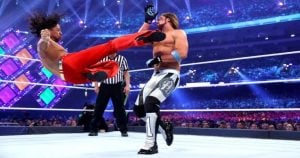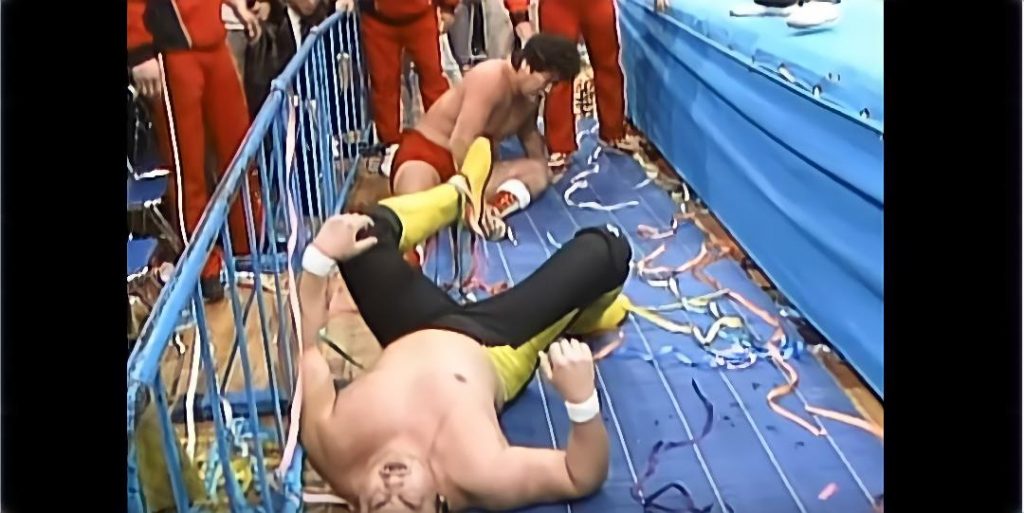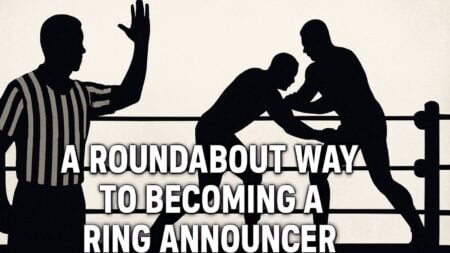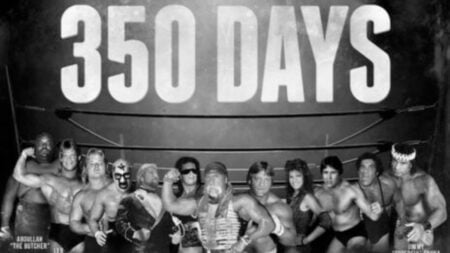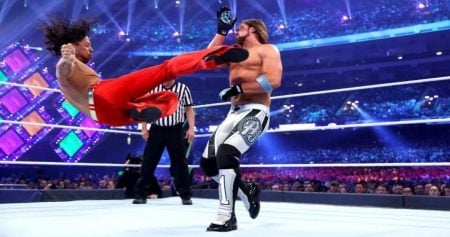Kawada and Taue and The Night They Brought A Bloodbath To All-Japan. When wrestling fans see or hear the words ‘All Japan Pro Wrestling’, a few specific things come to mind. Excellent technical wrestling. High-impact bombs. Dangerous head-spikes. Stiff strikes.
Classic pure wrestling matches. Essentially, AJPW was and is the home of pure wrestling without over-the-top gimmicks or angles. One doesn’t think of All Japan and think of hardcore violence and weapons shots.
Except in this case.
This match was the exception to the rule in All Japan. Instead of being a pure wrestling match or a classic NWA-style brawl, it was a violent bloodbath. It was so different compared to everything else All Japan showcased, yet like every other big AJPW feud, it was successful. It elevated the careers of the two wrestlers involved and helped draw thousands of curious fans.
It was one of All Japan’s most successful feuds during the early 1990s because it was so intense and personal. And it only made Kawada’s later betrayal that much more poignant.
These two wrestlers had many matches together over the years, but this particular match encapsulates their feud better than any other. That’s why it warrants revisiting more than any other.

Kawada and Taue
The background
This match was different compared to other All-Japan matches because it was so violent. It eschewed the traditional, pure, and straight-laced matches promoter Giant Baba preferred and went in the opposite direction.
It was bloody, brutal, and barbaric. Kawada and Taue hit each other so hard that they bloodied each other badly. And since Baba had banned the act of blading, there’s a good chance this bleeding came the hard way.
In other words, Kawada and Taue hit each other so hard they bloodied each other for real.
But how did it get to this? How did two wrestlers get to hate each other so much that they basically got the promoter’s blessing to do the opposite of what the promoter wanted? Well, it’s a long story but an interesting one as well.
Once upon a time, Kawada and Taue were members of a stable called the Super Generation Army. That stable was led by Mitsuharu Misawa. Misawa had spent years wrestling as Tiger Mask II until All Japan suffered a major loss of wrestlers.
Genichiro Tenryu, one of the company’s top stars, left before Misawa unmasked and took many wrestlers with him. Baba answered this departure by pushing four younger wrestlers as future stars.
Those four wrestlers were Misawa, Kawada, Taue, and Kenta Kobashi. His plan was for them to become the quartet that would work together to become the stars that would carry the brand into the future.
But instead of them becoming a cohesive unit loyal to one another, they began to unravel almost from the beginning. Although Misawa managed to beat then-company ace Jumbo Tsuruta on June 8th, 1990, he couldn’t grow from there.
He lost his follow-up world title shot and then lost a #1 contender’s spot after that. Taue saw these examples of Misawa’s failures as signs that he wasn’t the leader everyone thought he was.
As a result, Taue left the SGA and joined Misawa’s then-rival Tsuruta and his Army. Just like that, the dream of four future stars working together like the Four Horsemen fell apart.
Misawa was angry at this betrayal but didn’t show it; he was the stoic, the man that was always in control of his emotions. Plus, he had Tsuruta himself to deal with. Therefore, Misawa left Taue to Kawada, his right-hand man and close friend.
And Kawada was more than happy to deal with him since Kawada had his own frustrations to deal with and Taue would make for an ideal punching bag.
You see, even though Kawada and Misawa were friends, they had begun to drift apart. Kawada had begun to grow jealous of Misawa’s success and fame while he was left to languish in Misawa’s shadow as his #2.
Kawada thought himself the better wrestler – and many people supported this at the time – but it was Misawa that got all the attention. But Kawada didn’t want to make a big fuss out of all this, so he gritted his teeth and did his duty.
Of course, Taue wanted to prove to Tsuruta that he was worthy of the ace’s time. Taue, who to this day is widely considered the weakest of the Four Pillars, wanted to show the world what he could do.
But he was a smart man. Even as early as 1990, Taue was aware of his limitations compared to the other Pillars. He wasn’t as tough or stoic as Misawa. He lacked Kawada’s striking expertise and amateur credentials. And he lacked Kobashi’s raw power and babyface fire.
But there was one thing Taue excelled at more than the other three: craftiness. Taue was ready and willing to cheat, be underhanded, and exploit weaknesses to win.

But on this day, Taue decided to focus on something else: he decided to be as violent towards Kawada as possible.
A fight from beginning to end
Taue must’ve hated Kawada as much as Kawada hated him because there was no formal introduction in this match. The moment Kawada stepped on the apron to enter the ring, Taue rushed him and booted him to the floor.
Kawada tried to even the score on Taue with an early lariat but Taue simply fired back with the same. Then Taue, a former sumo wrestler and one of the heaviest wrestlers in All Japan, dove through the ropes like Bryan Danielson to inflict more punishment on Kawada.
His anger and hatred consumed him so much that he was willing to go way out of his comfort zone and dive like a cruiserweight if it meant hurting Kawada more.
Things only got wilder from there. Taue bashed Kawada with a steel chair right in his knee and then tried to stop him from getting back into the ring by stomping his head.
But Kawada had enough of this and pulled Taue to the floor by his leg, and then proceeded to grind Taue’s head into the barricade. He followed that with two vicious chair shots to Taue’s head that busted Taue open badly.
So badly that it looked like Taue hadn’t even bladed but had been opened up the old-fashioned way. How this violence didn’t lead to a disqualification remains a mystery.
The match did go back to being about pro wrestling soon after. And yet, it didn’t come across as a ‘worked professional wrestling competition’. Even with all the wrestling moves, this was a bout between two men who wanted to end each other’s careers.
Nothing looked careful or protective. Kawada and Taue threw each other’s bodies into hard surfaces with what looked like reckless abandon.
Kawada’s knee got smashed into anything and everything, which gave the impression that Taue was trying to cripple him. Even as Taue locked Kawada in a heel hook in the ring and Kawada had to kick with his free leg, winning the match seemed like an afterthought.
Kawada wanted to punish Taue for betraying the SGA, while Taue wanted to make Kawada regret being born.
Taue took most of the match by wrecking Kawada’s leg and though that taking such a cheap and easy path would win him the match. But Taue underestimated Kawada. Kawada was always at his best when he traded vicious strikes with his opponent and had fought to maintain control.
That was the case here. Taue thought he would beat Kawada and hurt him badly but Kawada fought back…literally.
The match descended into as close to an ugly back alley fight as it could get in a wrestling ring. at one point, Kawada literally left a bloody handprint on Taue’s cheek, they were fighting so hard.
The contest took another turn back to wrestling with a few ‘holds’ and ‘moves’, yet the realism remained. Through their body language, both Kawada and Taue looked like they were still trying to demolish each other first and win the match second.
But despite Taue’s best efforts at destroying Kawada’s leg to make him stop fighting, Kawada pulled a surprise move out at the end.
Kawada smashed Taue’s head and neck in with a lariat to the back of the head that looked like it legit knocked Taue out. That was enough for Kawada to win the battle, but the war was far from over.

Wider context
Although the Kawada/Taue feud was secondary to the Misawa/Tsuruta feud at the time, it was just as important. Singles matches like this weren’t as common as multi-man tags in All Japan during those days.
Because of that, Kawada and Taue brought their heat into a larger story. Misawa and his army fought Tsuruta and his army many times throughout 1990, all the way until late 1992.
In many of their big matches, the intensity and violence of the Kawada/Taue feud was juxtaposed with the straight-laced and more ‘professional’ feud between Misawa and Tsuruta.
So while Misawa and Tsuruta brought the wrestling, Kawada and Taue brought the violence.

Taue cheap-shotted Kawada countless times in those big matches and looked for any excuse to attack his bitter archrival. Meanwhile, Kawada would wait until he was the legal man against Taue and would then proceed to tear Taue to shreds.
Their moments of unbridled anger buoyed against the more subdued and ‘pure’ storytelling of Misawa and Tsuruta.

And yet, the feud between Kawada and Taue continued for almost three full years. They had such an intense and personal war that they were able to make people believe they truly loathed one another. This intensity made what happened next all the more shocking.
When Tsuruta had to step away from wrestling due to a hepatitis diagnosis, his feud with Misawa ended. Misawa, for all intents and purposes, had won the war, especially after he finally beat Stan Hansen in August 1992 to win the Triple Crown Heavyweight Champion.
A new ace was crowned. But it takes two to tell a story and Misawa suddenly found himself without a dancing partner.
As all of this happened, Kawada began to wonder if being in Misawa’s #2 really was that beneficial. Yes, he was getting lots of attention and big paydays alongside the new ace.
But with Misawa as champion and Tsuruta-gun defeated, there was no need for Kawada to really gatekeep anymore. He had beaten Taue so many times and Taue had done the same to him.
It wasn’t long before Kawada’s personal desires became more important once again. Thus, after winning the 1992 World’s Strongest Tag Determination League, Kawada made a big career change: he turned his back on Misawa. Kawada no longer wanted to be the #2 babyface behind Misawa; he wanted his own glory.
That was surprising but not unexpected. Kawada’s story as Misawa’s #2 had very much run its course. But what really sent people into a frenzy was Kawada’s next big choice. After going to a 30-minute draw in the 1993 Champion Carnival, Kawada extended his hand to his opponent and that opponent accepted.
The opponent in question here…was Akira Taue.
Akira Taue, the man that tried to end Kawada’s career, the man on whose face Kawada had left a bloody handprint, shook hands with Kawada. A month later it was official: The Holy Demon Army was born.

Kawada and Taue –
Legacy
There’s a good reason why we look back at matches like this: they look more real. In today’s wrestling environment, there is a noted lack of blood feuds that feel genuine and realistic.
Wrestlers may say scathing things on the mic or dig up some dirt to get a big reaction. And yet, when it comes down to the actual wrestling, it’s rare to see two wrestlers working like Kawada and Taue did here.
There were so many small details and subtleties in how they moved that made this feel like a real fight. It was the polar opposite of the style of wrestling product All Japan produced. There was so little choreography in the action, with almost everything coming off as improvised based on circumstance.
The grounded exchange that saw Kawada trying to literally kick his way out of a submission hold added intensity and excitement to what would’ve otherwise been a boring submission heat segment.
This 12-minute match accomplished more from bell to bell than what most rivalries accomplish in over a month. Seeing these two men fight here wasn’t only entertaining here, but they left viewers wanting more.
The ending wasn’t decisive by any means, yet it was believable as a sudden burst of adrenaline from Kawada leading to a knock-out blow to Taue’s head.
Truly, it’s a gem of a forgotten match. Most people only remember All Japan’s glory days for the long, drawn-out wrestling matches that they forget that All Japan was able to showcase different stuff like this as well.


